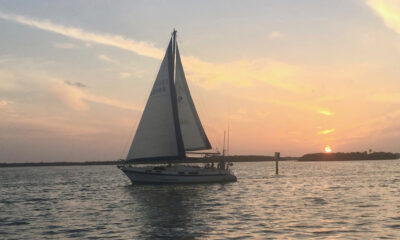Thrive
Conservationist: Thanks to red tide, St. Pete’s in for a ‘Summer of Slime’

Part One in a series.
Amid the worst red tide St. Petersburg has experienced in over 50 years, city officials are scrambling for answers as to why it is so severe, and searching for solutions moving forward.
City council opened Thursday’s meeting with local scientists and experts giving presentations on the issue to try and provide some insight for councilmembers and the public – both of whom were heavily engaged in the discussion that lasted over 90 minutes amid a full agenda.
Two resolutions were unanimously passed following the discourse, including one calling on Governor DeSantis to declare a state of emergency. Councilmember Darden Rice proposed the resolution in the hopes that it will not only aid in financing the dead fish cleanup process but also to address possible health issues for citizens and city workers stemming from the disaster.
“If the state of emergency can help direct the Department of Health to provide us more resources for our citizens who are going to be suffering …,” said Rice. “We need help from the state.”
Rice also suggested a resolution asking Pinellas County to extend the annual ban on fertilizer sale and use past the usual Sept. 30 end date.
Despite current efforts from officials to get the problem under control, J.P Brooker, Director of Florida Conservation for the Ocean Conservancy, offered a grim forecast.
“In my opinion, we’re in for a summer of slime,” said Brooker.
Dr. Kate Hubbard, Research Scientist for the Florida Fish and Wildlife Commission, said the toxic algal bloom started off the coast of Ft. Myers and that winds and tides have pushed it north. Red tide is now present from Sarasota County to Pasco County, but is by far the most concentrated in Tampa Bay along the coast of St. Petersburg.
“We haven’t seen these levels since 1971,” said Hubbard.
Public Works Administrator Claude Tankersley said the city has been addressing the problem since June 21, working almost 23 days straight. Between 150 and 200 employees have been assigned, with many working 12 hours a day, seven days a week. On Thursday alone, Tankersley said that 142 tons were collected in the St. Pete vicinity.
Tankersley said they have also been contracting help on an emergency basis, including shrimp boats and sports fishermen, and even using harvesters that normally would collect seaweed. He added that it has truly been a team effort.
The legislative delegation, Pinellas County, Fish and Wildlife Commission, the Coast Guard, both Tampa Bay Watch and Tampa Bay Estuary programs, Keep Pinellas Beautiful, and various homeowners associations are just some of the organizations Tankersley mentioned working with. “It goes on and on,” he said.
“One of the things I really love is that Bayfront Health and Deuces Live has provided cold treats for our workers … And they have been very grateful for that kind of outreach and support from the community.”
Tankersley said the city has already spent around $350,000 in labor and overtime, $250,000 in equipment, and around $100,000 on contracting services. They are currently spending about $61,000 a day – unbudgeted, out-of-pocket expenses to the city.
The “lost opportunity” costs are even greater; he expects this to reach around $1.2 million.
Tankersley said that pulling city workers off the myriad of projects that they would be normally doing will still need to be addressed, and they will still need to spend the money to pay them to do so. Neglecting these assignments also raises that cost.
“A small pothole is relatively easy to fix,” said Tankersley. “But the longer you let the pothole go unfixed the bigger it gets and the more expensive it gets to fix.”
“We’re having to make the daily decision, which is more important? Getting up the dead fish out of the water so that we don’t have more of a bloom, or so that our citizens can breathe, or fixing a pothole.”
The county has reported that over 700 tons have been removed, and Tankersley said that he would estimate that 600 tons have come from around St. Pete.
Brooker said that there is no one factor to place the blame on for this year’s bloom – there is no “smoking gun.” He said the recent Piney Point disaster that released hundreds of millions of gallons of nutrient-rich toxic water has certainly exacerbated the situation, but so has the Saharan air layer that has been unusually prominent this past week. He added that the Gulf of Mexico being three degrees warmer than usual, along with the hundreds of tons of dead fish already removed, have also contributed to the severity.
As for as solutions at the municipal level, Brooker said that strengthening fertilizer ordinances is a start. While St. Pete already restricts fertilizer use from June 1 to Septe. 30, he suggested following Miami-Dade County’s lead in extending the ban. Removing the dead fish as quickly as possible and improving stormwater runoff and sewer systems will also aid the cause.
“We are at a crossroads when it comes to Florida water,” said Brooker. “And what we’re seeing here in Tampa Bay right now is proof we are at that crossroads.
“Everyone from all walks of life – from City Hall to Tallahassee to Capitol Hill – we need everyone to step up and lean forward for Florida’s water.”
For interactive maps showing the severity of red tide in the area, as well as Piney Point updates, visit the FWC website here.
To report fish kills and for other city-specific information, visit the City of St. Petersburg’s website here.
Saturday: Part Two – an in-depth examination of the causes of red tide.








Anna
July 22, 2021at3:51 pm
Wholeheartedly agree about Piney Point – it needs to be addressed ASAP! If anyone knows of any organization(s) accepting volunteers to assist with the cleanup of our precious, perished sea-life due to this horrific and heartbreaking man-made catastrophe, please reply.
Robyn
July 16, 2021at4:57 pm
Informative article, thank you
Wayne Clifford
July 16, 2021at4:12 pm
Why so afraid to say the obvious? Piney Point put that enormous load of fertilizer in the Bay and now the Bay is dying. A solution must be found for the mess at PP, those liners aren’t getting any stronger.